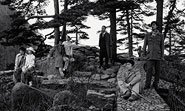
I would like to draw attention to a remarkable work that is viewble in Manhattan at the Asia Society from now until September. It is Yang Fudong’s Seven Intellectuals in a Bamboo Forest. From 2003 to 2007 this visual artist from Shanghai who had previously been silent for three months in order to examine his relationship to language next made a sequence of films, one a year, which took as their point of departure the Seven Sages in a Bamboo Forest an influential and mythic 5th century work about a group of intellectuals who dropped out of their careers in government service early in their lives and devoted themselves to drunkenness, the composition of poetry, the playing of musical instruments and engaged in qingtan, the practice of pure conversation.
The aesthetic ideal of this group inhabited Chinese art and cultural life for centuries, moved on to Japan taking root there as well. Often if you see a few guys strolling on a scroll, it’s probably the sages. For a very long time any reference to them was regarded as a way to “elevate ones cultural profile.” The sages were an allusion to the good life. A nod to detachment and profound amusement, even if there were no similar qualities in one’s own life. What Yang Fudong does in his films is represent the earlier work in five beautiful and stylish ways. Style here is standing in for or approximating beauty. Seven young men and women in the first film are heading up the trail of one of China’s most sentimental and revered scenic mountains. The young intellectuals variously kiss, ponder, posture and illustrate a sort of pleasurable aestheticism. The second film takes a more 90210 approach. The artists are now arguing making love and striking poses, but in the city in apartments. In the third film they remove themselves to a country setting and the men wear straw hats, roll up their pant legs and lead oxen on yokes through muddy puddles. The girls, looking great and melancholy plead with the men for a little attention and love, some leftover intensity after all the work. The pieces are intended to investigate gender, but so far they seem like more of the same. Like same ole. In number four they go to the coast for further adventures -- with large sea creatures like sharks instead of oxen, and not puddles but instead the sea. And at last they return to the city, another city perhaps and something has happened gender-wise. The vibe now is hallucinatory, the gender sort of queer. Nature is explored in urban fish tanks. Men now move among live sharks, and in stylish restaurants and in bars they dance solo, ecstatically with their shirts off. Everything’s fog and steam and luster now. People and things are no longer clear, separate; the entire world is the artist’s dream. The forest is here, everywhere we turn. I’m encouraging all my poet friends to go and see this modern trip. Why I think it’s our (poets’) business is that in these moving scrolls Yang Fudong awakens the intensity and values of the artist group. The reality of humans as an investigative aesthetic force. I mean why should poets feel limited to the terrain of thinking and writing. Why not poems, the action. Yang Fudong’s project underlines where poets do go already – wherever humans are found culturally and we ought to shamelessly seize the project of being actors, sages, scholars ourselves, walking around without a story or a line. Without a panel, a reading or a talk. Maybe just a pulse. And call that art.
Eileen Myles was born in Cambridge, Massachusetts, and was educated at the University of Massachusetts...
Read Full Biography

